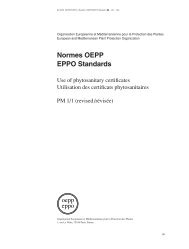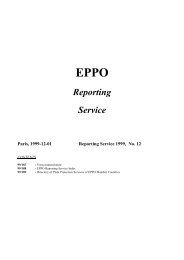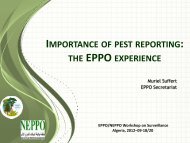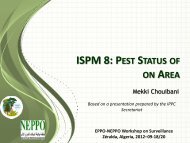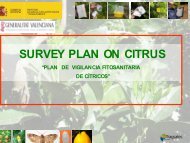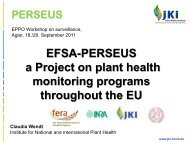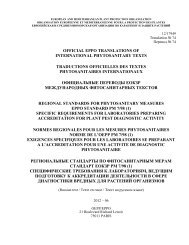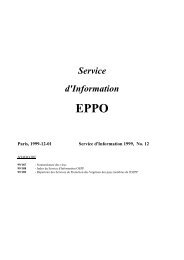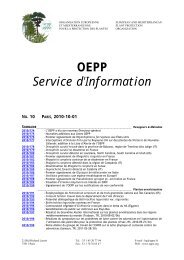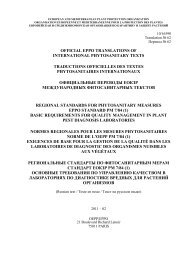EPPO Reporting Service - Lists of EPPO Standards - European and ...
EPPO Reporting Service - Lists of EPPO Standards - European and ...
EPPO Reporting Service - Lists of EPPO Standards - European and ...
You also want an ePaper? Increase the reach of your titles
YUMPU automatically turns print PDFs into web optimized ePapers that Google loves.
<strong>EPPO</strong> <strong>Reporting</strong> <strong>Service</strong> – Pests & Diseases<br />
Source: Brasier CM, Vettraino AM, Chang TT, Vannini A (2010) Phytophthora lateralis<br />
discovered in an old growth Chamaecyparis forest in Taiwan. Plant Pathology 59(4),<br />
595-603.<br />
Additional key words: new record Computer codes: PHYTLA, TW<br />
2011/028 Phytophthora lateralis detected again in the Netherl<strong>and</strong>s<br />
In 2005, Phytophthora lateralis (<strong>EPPO</strong> A1 List) was found for the first time in the<br />
Netherl<strong>and</strong>s in the province Drenthe on Chamaecyparis lawsoniana. All C. lawsoniana<br />
plants in the nursery concerned were destroyed. Subsequent annual surveys on P. lateralis<br />
were focussed on this nursery <strong>and</strong> its vicinity <strong>and</strong> confirmed the absence <strong>of</strong> the disease.<br />
However, in 2010 P. lateralis was detected again on C. lawsoniana in a nursery located in<br />
Almedo (province <strong>of</strong> Overrijssel). No link could be established between these two findings<br />
(the two nurseries are 85 km apart).<br />
In Almedo, the infected plants were found in a plot <strong>of</strong> 400 m² in which approximately 2000<br />
Chamaecyparis plants were grown. During a field inspection, some plants showing brown<br />
discoloration at the stem base <strong>and</strong> general decline were noticed. The pathogen was<br />
isolated on agar medium <strong>and</strong> PCR testing confirmed the presence <strong>of</strong> P. lateralis. The<br />
possible sources <strong>of</strong> this infection have been investigated but could not be determined.<br />
Imports <strong>of</strong> Chamaecyparis lawsoniana from outside Europe are prohibited, <strong>and</strong> there was<br />
no evidence that planting material originally produced by another Dutch nursery was the<br />
source <strong>of</strong> infection. Although it could not be excluded that infected soil adjacent to roots<br />
<strong>of</strong> non-host plants might have been a pathway, nothing could confirm this hypothesis.<br />
The infected area (approximately 100 m²) was delimited by collecting <strong>and</strong> testing<br />
additional plant samples. All plants in the infected area, as well as those located within a<br />
buffer zone <strong>of</strong> 2 m radius will be destroyed. Movements <strong>of</strong> the remaining Chamaecyparis<br />
plants will not be allowed until 2011-09-31 (<strong>and</strong> only after confirmation <strong>of</strong> the absence <strong>of</strong><br />
P. lateralis). Precautions will also be taken to avoid the dissemination <strong>of</strong> spores by human<br />
activities (e.g. by cleaning <strong>of</strong> machinery, equipment <strong>and</strong> shoes). Annual surveys on P.<br />
lateralis will continue in the Netherl<strong>and</strong>s.<br />
The pest status <strong>of</strong> Phytophthora lateralis in the Netherl<strong>and</strong>s is <strong>of</strong>ficially declared as:<br />
Transient, under eradication.<br />
Source: NPPO <strong>of</strong> the Netherl<strong>and</strong>s (2010-11).<br />
Additional key words: detailed record Computer codes: PHYTLA, NL<br />
2011/029 Situation <strong>of</strong> Phytophthora lateralis in France<br />
In France, Phytophthora lateralis (<strong>EPPO</strong> A1 List) had been isolated from Chamaecyparis<br />
lawsoniana on two occasions (in 1996 <strong>and</strong> in 1998). The origin <strong>of</strong> these detections could<br />
not be fully traced-back (it can be recalled that imports <strong>of</strong> C. lawsoniana from third<br />
countries are prohibited in the <strong>European</strong> Union). The disease was no longer reported until<br />
2005 when tree mortality <strong>and</strong> symptoms resembling those <strong>of</strong> P. lateralis were observed on<br />
several hedges <strong>of</strong> C. lawsoniana in Finistère department (Bretagne region, Western<br />
France). In Bretagne, C. lawsoniana trees were planted during the 1970s as windbreaks<br />
after removal <strong>of</strong> the traditional hedgerows (i.e. during the transformation <strong>of</strong> the historical<br />
low-intensity farming system into a more intensive one). Several samples were collected<br />
3




